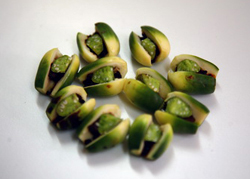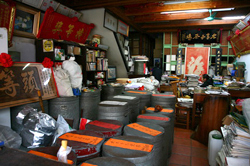10 A.M. AN DONG MARKET
From the breakfast place, turn right and continue south down Fuxing South Road. Take a right on Lane 148, Fuxing South Road (Taipei's side lanes are named after the roads they branch off).
Check out the betel-nut stand near the corner, and try some if you dare. This mild intoxicant is a favorite in Taiwan, India and some parts of Southeast Asia (but not mainland China). Working-class types here swear by the stuff, and you can tell a betel-nut fan by the telltale red stains around the mouth.
Across Taiwan, especially outside major cities, 'betel nut beauties' -- 20-something females in microscopic outfits -- attempt to lure buyers to their roadside stands. But in Taipei, you're more likely to find a cranky middle-aged man or smiling granny selling the nuts. If you try it, bite or clip off the rind of the nut, then chew it like gum -- don't swallow it and be sure to spit out the juice, otherwise you're likely to get sick to your stomach. A small bag of nuts costs $1.50.
Continue walking down Lane 148 until you reach the An Dong market on your left, at No. 75 Rui An St. Here's your chance to check out a traditional Taiwanese market. Many are losing business to supermarkets, but they aren't extinct yet. Check out the butcher and the fruit stands. You'll also find shops selling 'ghost money,' paper that's burned for good fortune and to appease the gods or wandering spirits.
Leave the market and cut across Rui An Street to Lane 180, Rui An Street. There's an old-fashioned tea shop called Lao Ji Zi on your right, at No. 5 Lane 180. This is run by the Tseng family, who own tea fields in Taiwan and on the mainland.
Big metal canisters store their crop: oolong tea picked from Alishan, gaoshan (high mountain) tea from Nantou County, and some much-prized puer tea, picked from trees in China's Yunnan province. The half-jin (500-gram) tins of tea make great gifts; a basic oolong costs $9, a tin of the gaoshan variety costs about $60. Say hello to Mrs. Tseng, who runs the shop while her husband tends to the fields in central Taiwan.
上午10點(diǎn):安東市場
從永和豆?jié){店出來,往右拐,一直往南沿著復(fù)興南路走。到了復(fù)興南路148巷(臺北的巷子名前面都要加上主路的名字)再往右拐。
如果你夠膽量,就試試角落里的那家檳榔攤。檳榔在臺灣、印度以及東南亞的其他一些地方(但不包括中國大陸)深受大眾喜愛。這里的勞動階層對檳榔十分鍾情,而且從紅紅的嘴巴你就能很容易分辨出誰是檳榔愛好者。
在整個(gè)臺灣,尤其是大城市周圍,“檳榔西施”──指那些穿著暴露的20多歲的年輕女孩──會想辦法把買主們吸引到她們的攤位前。但是在臺北,向你兜售檳榔的更有可能是一個(gè)看起來有些古怪的中年男人或者滿面笑容的老奶奶。如果你愿意嘗嘗的話,要先咬掉或者剪掉檳榔殼,然后像嚼口香糖一樣咀嚼檳榔。別咽下去,而且一定要把檳榔汁吐出來,要不然你的胃可能會不舒服。一小袋檳榔的價(jià)格是1.5美元。
繼續(xù)沿著148巷向前走,你會看到左手邊瑞安街75號的安東市場。在這里,你可以一睹臺灣傳統(tǒng)市場的風(fēng)采。雖然許多商鋪的生意都被超市搶去了,但這里的商鋪還沒有被完全擠垮。你可以到生肉和水果攤位去看看。你還會看到一些賣“冥幣”的商鋪,人們燒紙錢是為了祈求好運(yùn),告慰神靈。
從市場出來,穿過瑞安街到瑞安街180巷,在右手邊的180巷5號你會看到一家名為“老吉子”的茶行。茶行老板姓曾,在臺灣和大陸都有茶田。
大大的金屬罐子里存放著茶葉:這里有從阿里山采摘的烏龍茶、從南投縣采摘的高山茶以及一些來自中國云南省的備受贊譽(yù)的普洱茶。買半斤(500克)茶葉作為禮物送人是個(gè)很不錯(cuò)的選擇。一盒普通烏龍茶的價(jià)格為9美元,一盒高山茶的價(jià)格為60美元。別忘了和曾太太打個(gè)招呼,在丈夫照看位于臺灣中部的茶田時(shí),她就會幫忙經(jīng)營店鋪。















